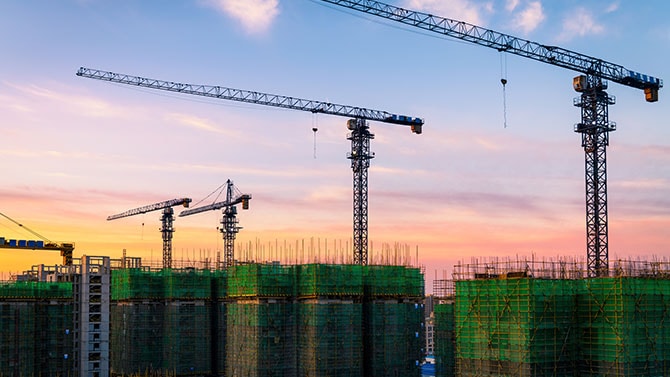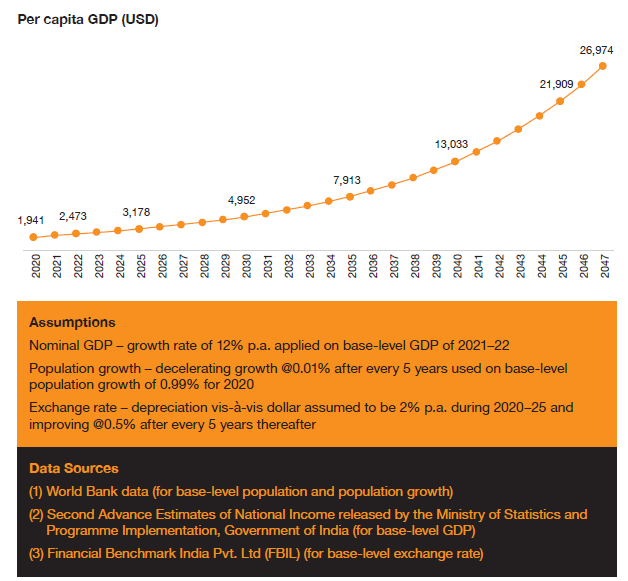Twenty-five years from now, India could exceed a per capita income of USD 26,000 – almost 13 times the current level – by unlocking some key areas that demand both investments and policy interventions.
By Ranen Banerjee
India has made significant progress over a span of three-quarters of a century since its independence. From a primarily agrarian economy in which agriculture contributes 56%1 of the GDP, the world’s largest democracy has transformed into a predominantly services sector economy. The services sector contributes to over 50%2 of the country’s GDP, while the share of agriculture stands at less than 20%.3 The nation has also strengthened its physical and social infrastructure over the last 75 years; that has resulted in life expectancy increasing to 69.4 years4 from 32.15 years, and maternal and infant mortality rates improving to 1.036 from 20,7 and 308 from 133-9 respectively.

India has created a strong economic base and is poised to achieve the status of a developed country over the next 25 years. Our projections indicate that India@2047 can exceed a per capita income of USD 26,000 – almost 13 times the current level. This is both possible and plausible in USD terms and not on purchasing power parity (PPP) terms. Such increased per capita income may be achieved on the basis of:
- a realistic assumption of a nominal GDP growth rate of 12%
- a modest deceleration of 0.01% in the population growth rate in a block of every five years
- INR/USD depreciation of 2% per annum up to 2025 and thereafter appreciating 0.5% in a block of every five years.
India’s growth potential therefore makes it an attractive destination for all three types of investors – resource seekers, efficiency seekers and especially market seekers.

Destination India
For market seekers, the scale and emerging consumption patterns that India could offer over the next quarter of the century are immense. With a large domestic consumption base, seventh-highest final consumption expenditure in the world,10 private consumption and government consumption making up over 70% of the GDP, and per capita income poised to grow at rapid rates, there are potential opportunities for market seekers. As per the World Economic Forum’s report on the Future of Consumption (2019), India will add around 140 million middle-income and 21 million high-income households by 2030. Upper middle-income and high-income households will drive 61% of the consumption in 2030 compared to 37% in 2018.11 While there may be some undershoot of these numbers owing to disruptions caused by the pandemic, the trajectory is likely to be similar.
The median age of the Indian population is projected to be 31 in 2030 compared to 42 in China and 40 in the US, thereby making India a country with the largest working-age population in the world.12 And by 2030, 90 million new households will be headed by millennials. These digital natives will have a vastly different approach to consumption and expectations regarding service delivery by both the Government and private sectors. With growing per capita incomes, India@2047 will be comparable to current day economies such as Spain and Portugal that currently have a per capita income of around USD 25,000.13 However, the catchup needed to meet the aspirations of young and upwardly mobile Indians is immense. For instance, life expectancy in Spain and Portugal is around 80 years, while maternal mortality is under 0.10.
Both the Government of India (GoI) and India Inc. could aspire to achieve the economic and social outcomes for India @2047 by destressing the economic and social fault lines and reimagining the future of a committed India. To harvest the gains from the economy, India will need to unlock the following key focus areas that demand both investments and policy interventions:
- Skills unlock
- Education unlock
- Healthcare services unlock
- Gender unlock
- Logistics unlock
- Manufacturing unlock
- Regulatory unlock
Skills unlock
Debates around India’s demographic dividend are common. Efforts are needed to upskill millions of our working-age youth nationwide to make them industry ready and future fit for the new sets of jobs that are being created owing to the disruption of existing business models. This will also put to rest arguments about the young population being a boon or a bane.
The country stands to benefit if we are able to skill/upskill the working-age youth to make them employable not only in sectors in which India will consolidate and strengthen its manufacturing capabilities, but also in the services sectors witnessing strong growth. Acquiring relevant skill sets aligned to futuristic goods and services such as servicing of robots, repair of augmented reality (AR)/virtual reality (VR) devices, and manufacturing of chips would also be useful going forward.
Skilling India, therefore, is an urgent imperative if we are to avoid converting the demographic boon to a bane. This goal may be achieved through close cooperation between private, public and civil society organisations. One district one skill (ODOS) could be a starting point, mirroring the one district one product (ODOP) scheme. This will help build a local economy around a product with efficiencies of scale kicking in, and prevent internal migration that puts pressure on urban centres.
Education unlock
The Government spend in the education sector in India has been under 3.5%14 of the GDP, compared to a global mean of about 4.5% of the GDP. We need a calibrated ramp-up of the education sector’s budget from the current levels to match global levels with a focus on spend efficiency. However, it may be noted that the Government has been cognisant of the rigidities in the Indian education system and the need to align it with present-day requirements. The new National Education Policy (NEP) 2020 is an effort in this direction, and the implementation of this policy in all earnestness is the need of the hour. The Government has also taken some steps to move away from rote learning and make education more application based. For example, the announcement of the Combined University Entrance Test (CUET) for admission to central universities instead of students’ admissions only on the basis of the marks is a step in the right direction.
Indian companies would also need to demonstrate agility by moving to skill-based hiring rather than qualification-based hiring. This will allow students to explore skill development rather than pursue degrees over longer time periods. It would also enhance quality as skill-based courses will focus on improving workforce excellence. The standard of teachers and their remuneration would also need specific interventions from the Central and state governments.
Healthcare services unlock
The WHO/UNICEF Joint Monitoring Programme estimated that India incurred a loss of USD 189 billion (7.9% of the GDP)15 in 2015 owing to households with poor sanitation facilities. A year prior to that the GoI launched the Swachh Bharat Mission (SBM) to make India Open Defecation Free (ODF) and improve sanitation facilities in households. The WHO/UNICEF report also estimated that if SBM achieved its intended objectives, the amount of losses incurred would be reduced to USD 64 billion or 2.7% of the GDP. These numbers show the importance of improving health services and access to healthcare facilities.
The Government has done well in strengthening the primary health centre (PHC) network. The next stage of the PHC evolution will be the introduction of telemedicine in these centres. The proliferation of smartphones in the country may be leveraged to spread awareness on health and hygiene, and that could help reduce the unproductive days of the workforce owing to illnesses and health issues.
The National Health Insurance scheme could be a game changer in the development of secondary and tertiary healthcare infrastructure. Quality checks and incentivisation can be introduced through this insurance scheme to prompt the health facilities to deliver quality health services. For example, a health facility delivering better quality of service could be given monetary recognition, and district-level competitions between health service providers based on patient feedback could also be organised.
India was spending an average of less than 1.5% of its GDP on health before increasing it to over 2%16 during the pandemic. Spain and Portugal spend around 6% and 8% of their GDP respectively on public health. India, therefore, needs to not only prioritise its spending on public health but also increase it significantly over the coming years to yield rich dividends for the economy.
Gender unlock
The labour force participation rate (LFPR) in India is around 40%17 compared to over 74% in Spain and around 75% in Portugal.18 The primary reason for this low LFPR is the absence of women from the workforce in India with a female LFPR of around 20%.19 The female LFPR in Portugal is 72% while for Spain, it is 69%.20
If we are to increase our numbers we would need to ensure that girls complete their education and find jobs. The ODOS scheme suggested earlier could have a sub-component such as one district one women skill (ODOWS) to provide skilling opportunities to women and make them more locally employable. Women earning and proactively participating in the workforce positively impact a family’s prosperity, can help eradicate poverty and strengthen the journey towards building a prosperous, safe and healthy India@2047.
Logistics unlock
The logistics cost incurred by India is estimated to be 14% of its GDP. According to a NITI Aayog RMI India report, the target is to reduce this to 10%. There are huge inefficiencies in the logistics chain owing to which there are several negative consequences such as sub-optimal use of logistics assets, inefficient fuel consumption, environmental pollution and loss of economic growth opportunities.
The GoI has launched Gati Shakti with a stated vision of incorporating infrastructure schemes of various ministries and state governments such as Bharatmala, Sagarmala, inland waterways, dry/land ports, and Ude Desh ka Aam Nagarik (UDAN). Economic zones such as textile clusters, pharmaceutical clusters, defence corridors, electronic parks, industrial corridors, fishing clusters and agri zones will also be covered to improve connectivity and make Indian businesses more competitive. India will also leverage technology extensively, including spatial planning tools. This is an important initiative and is likely to unlock the logistics bottlenecks currently faced by the Indian economy.
Manufacturing unlock
India has been aspiring to grow its manufacturing sector to account for 25% of the economy from the current levels of around 15%.21 The recent supply chain shocks experienced by companies and countries owing to the pandemic and fractured geopolitics present a unique opportunity to India to dominate this space.
The GoI’s Production Linked Incentive (PLI) scheme has been launched at an opportune time to ride this growth wave. Simultaneously, India needs to focus on new-age manufacturing in the areas of space, telecom, renewables and metaverse devices. The National Skill Development Mission should also work towards making such skills available for the new-age manufacturing sector.
Regulatory unlock
There has been an enhanced focus on improving ease of doing business (EoDB) in India, with states competing to secure the top EoDB rank. There have also been significant improvements in the processes for setting up a business, obtaining approvals and conducting various inspections related to the running of a business.
However, sharper focus is needed in the challenging areas of contract enforcement, payments and dispute resolution. It may help to get all parties to adhere to the contractual terms. Judiciary support will be required to this end, by way of raising the bar for entertaining appeals on the outcome of arbitration proceedings. Similarly, the Government being the largest procurer should generally accept arbitration outcomes and go for further litigation in exceptional circumstances, improve its payment cycle for reducing the working capital requirements of businesses and free up locked capital for further sweating. Fast Track Commercial Dispute courts for enforcement of contracts could be another mechanism for the Government to explore.
Future-fit India
These unlock measures will require significant financial resources from the Government. The tax-to-GDP ratio for India has inched up to around 12%.22 Spain and Portugal have a tax-to-GDP ratio of over 35%.23 In the years to come, progressive formalisation and digitalisation of the Indian economy are likely to continue to provide buoyancy in the tax revenues, and the Government should have adequate resources to finance India’s journey towards becoming a developed country.
The Government has also embarked upon an asset monetisation scheme to mobilise resources and subsequently enhance its ability to advance infrastructure investments needed without negatively impacting fiscal health. It could also consider unlocking the logistics jam through infrastructure projects having cash flows and securitising those future cash flows instead of funding such projects from its annual budget. This could help the Government undertake more infrastructure projects without negatively impacting the budget deficits, much to the satisfaction of sovereign ratings agencies that frown upon higher deficits. The intent for the same has already been demonstrated through significantly higher allocation towards capital expenditure in the Union Budget for FY 2022-23.
The Indian economy, with its natural shock absorbers, has strong fundamentals built over 75 years and is highly resilient, as has been proved time and again. It owes its financial markets resilience to the growth of domestic institutional investors (DIIs) that stepped in when foreign institutional investors (FIIs) began exiting with the US Fed taper. It owes its tax revenue resilience to the increasing digitalisation and formalisation of the economy. India’s energy resilience emanates from the growth of renewables and ethanol in the energy mix. And last but not the least, its demand resilience arises from the large consumer base responsible for making India’s medium- and long-term economic outlook very strong.
India holds out hope of putting forward its best thinking to unlock these key areas. If all stakeholders come together as a community of solvers to put their might behind it, India@2047 will be firmly gliding through the expressway of a developed economy.
Sources
4. Women and Men in India 2021 by Ministry of Statistics and Programme Implementation
6. Women and Men in India 2021 by Ministry of Statistics and Programme Implementation
7. Health Survey and Development Report - Bhore committee,1946 National Health Portal
8. Women and Men in India 2021 by Ministry of Statistics and Programme Implementation
10. World Bank - Final consumption expenditure 2021
11. Future of Consumption in Fast-Growth Consumer Markets: India| World Economic Forum 2019
12. Future of Consumption in Fast-Growth Consumer Markets: India| World Economic Forum 2019
13. Euroindicators by EuroStat - 2021
15. Financial and Economic Impacts of the Swachh Bharat Mission in India | Unicef 2017
17. Women and Men in India 2021 by Ministry of Statistics and Programme Implementation
18. Employment and activity by sex and age: Statistics | Eurostat
19. Women and Men in India 2021 by Ministry of Statistics and Programme Implementation
20. Employment and activity by sex and age: Statistics | Eurostat
21. India GDP sector-wise 2021 - StatisticsTimes.com
22. Tax Revenues in 2021-22 | Press Information Bureau (Government of India) 2022
Contact us

Ranen Banerjee
Partner and Leader, Economic Advisory Services Government Sector Leader, PwC India














